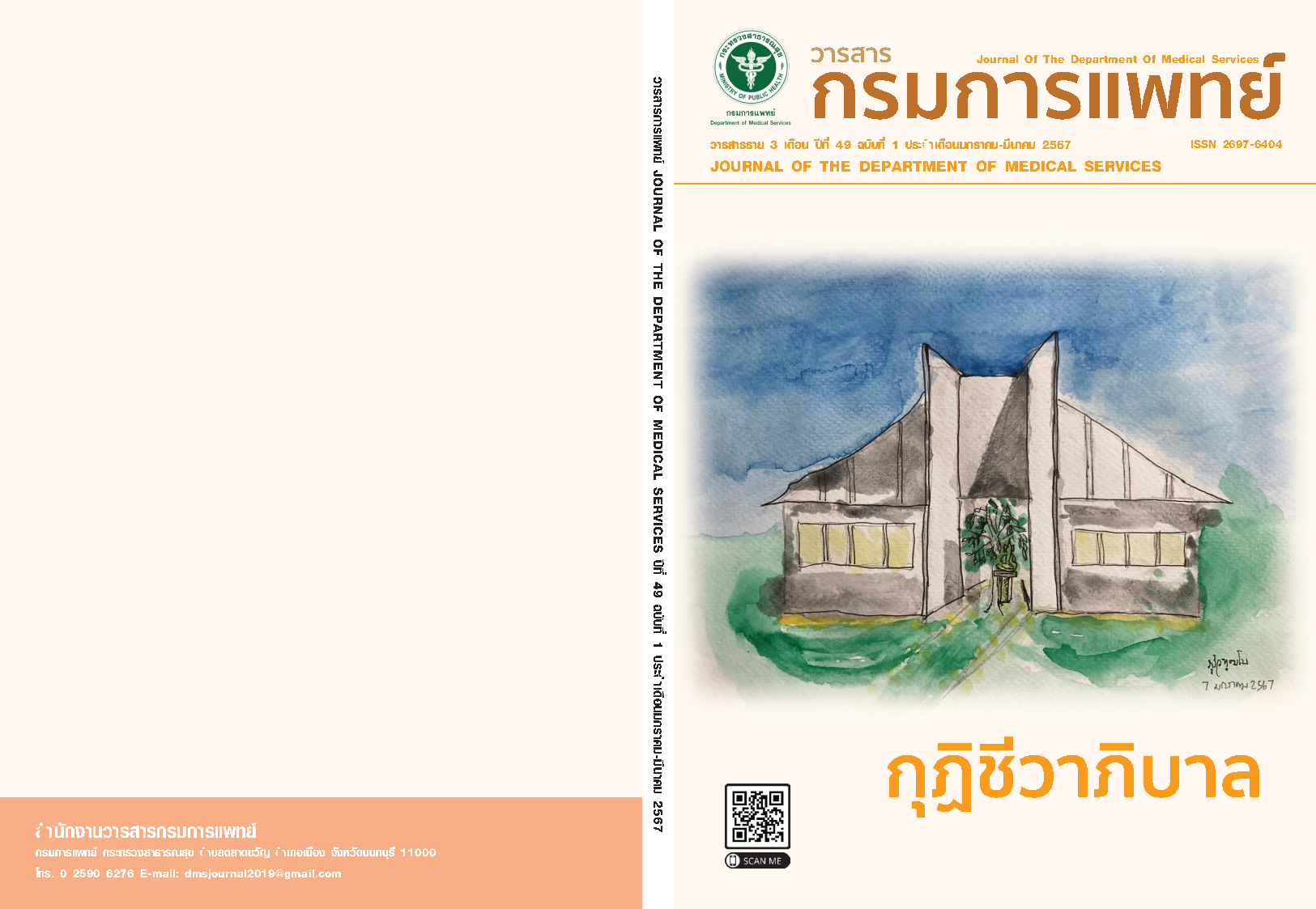Assessment of Skin Problems in Healthcare Personnel during COVID-19 Pandemic: A Cross-sectional Study from Central Vaccination Center
Keywords:
Skin problems, Healthcare personnel, COVID-19 pandemicAbstract
Background: During the coronavirus disease 2019 (COVID-19) pandemic, Thai government opened the Central Vaccination Center (CVC) for people to be vaccinated, so healthcare personnel had to apply extra personal protective equipment (PPE) during extended hours. This occurrence may be related to some dermatologic conditions. Objective: To determine the skin problems of healthcare workers operate at CVC and contributing factors. Methods: A cross-sectional descriptive study was performed by a random survey of healthcare personnel working at CVC from October 2021 to September 2022. Demographic data, job, hobby, type and duration of PPE usage, working hours, frequency and type of substance for hand washing, moisturizer application and dermatologic problems were collected from the questionnaire. The diagnosis of skin condition was performed by the researcher. Results: From a total of 406 healthcare personnel, the mean age was 34.8±10.8 years. Skin problems were observed in 291 persons (71.6%), the most common conditions were xerosis (66.7%), skin damage from pressure injury (63.9%), and acne vulgaris (60.1%), respectively. Younger age was a protective factor against skin problems (prevalence risk ratio; PRR = 0.98, p = .021). The vaccine injector had skin problems more than other jobs (PRR = 1.11, p = .038). N95 facial mask was a risk factor (PRR = 1.11, p = .004), whereas fabric mask was a protective factor for acne (PRR 0.84, p = .001). Using latex gloves with powder enhanced the risk of hand eczema (PRR = 1.15, p < .001). Hand washing with soap increased the risk of skin pruritus (PRR = 1.71, p = .022). Conclusion: Dermatologic problems in health workers are common during COVID-19 pandemic. The protective factors are younger age and wearing fabric mask. On the other hand, the risk factors include working as a vaccine injector, wearing an N95 mask, using latex gloves with powder, and hand wash with soap.
References
Mehta OP, Bhandari P, Raut A, Kacimi SE, Huy NT. Coronavirus disease (COVID-19): comprehensive review of clinical presentation. Front Public Health 2021;8:582932.
Lotf M, Hamblin MR, Rezaei N. Covid-19: Transmission, prevention, and potential therapeutic opportunities. Clin Chim Acta 2020;508:254–66.
Sharma A, Ahmad Farouk I, Lal SK. Covid-19: A review on the novel coronavirus disease evolution, transmission, detection, control and prevention. Viruses 2021;13(2): 202.
Personal Protective Equipment (PPE) Classification Systems. Personal Protective Equipment (PPE) Classification Systems - radiation emergency medical management. [Internet]. [cited 2023 Mar 21]. Available from: https://remm.hhs.gov/ppe_classification.htm
de Oliveira e Silva AC, Nogueira WP, Gir E, de Almeida SA, de Lima Barroso BI, Freire MEM. Limiting factors of face shield use for health professionals during the COVID-19 pandemic. Work 2021;70(2):355–63.
Hirschmann MT, Hart A, Henckel J, Sadoghi P, Seil R, Mouton C. Covid-19 coronavirus: Recommended personal protective equipment for the orthopaedic and trauma surgeon. Knee Surg Sports Traumatol Arthrosc 2020;28(6):1690–8.
Daye M, Cihan FG, Durduran Y. Evaluation of skin problems and dermatology life quality index in health care workers who use personal protection measures during COVID-19 pandemic. Dermatol Ther 2020;33:e14346.
Abiakam N, Worsley P, Jayabal H, Mitchell K, Jones M, Fletcher J, et al. Personal protective equipment related skin reaction in healthcare professionals during COVID-19. Int Wound J 2021;18(3):312-22.
Lin P, Zhu S, Huang Y, Li L, Tao J, Lei T, et al. Adverse skin reactions among healthcare workers during the coronavirus disease 2019 outbreak: a survey in Wuhan and its surrounding regions. Br J Dermatol 2020;183(1):190-2.
Battista RA, Ferraro M, Piccioni LO, Malzanni GE, Bussi M. Personal Protective Equipment (PPE) in COVID 19 pandemic: related symptoms and adverse reactions in healthcare workers and general population. J Occup Environ Med 2021;63(2):e80-5.
Choi EH. Aging of the skin barrier. Clin Dermatol 2019;37(4):336–45.
Gürlek Kısacık Ö, Özyürek P. Skin-related problems associated with the use of personal protective equipment among health care workers during the COVID-19 pandemic: A online survey study. J Tissue Viability 2022;31(1):112–8.
Spigariolo CB, Giacalone S, Nazzaro G. Maskne: The epidemic within the pandemic: From diagnosis to therapy. J Clinical Med 2022;11(3):618.
Teo WL. Diagnostic and management considerations for “maskne” in the era of covid-19. J Am Acad Dermatol 2021;84(2):520–1.
Techasatian L, Lebsing S, Uppala R, Thaowandee W, Chaiyarit J, Supakunpinyo C, et al. The effects of the face mask on the skin underneath: A prospective survey during the COVID-19 pandemic. J Prim Care Community Health 2020;11:1-7.
Jose S, Cyriac MC, Dhandapani M. Health problems and skin damages caused by personal protective equipment: Experience of frontline nurses caring for critical COVID-19 patients in Intensive Care Units. Indian J Crit Care Med 2021;25(2):134–9.
Cebeci D, Karasel S, Rıfkı D, Yesildağlı H, Kalfaoglu M. The effect of Personal Protective Equipment (PPE) and disinfectants on skin health during covid 19 pandemia. Med Arch 2021;75(5):361-5.
Downloads
Published
How to Cite
Issue
Section
License
Copyright (c) 2024 Department of Medical Services, Ministry of Public Health

This work is licensed under a Creative Commons Attribution-NonCommercial-NoDerivatives 4.0 International License.
บทความที่ได้รับการตีพิมพ์เป็นลิขสิทธิ์ของกรมการแพทย์ กระทรวงสาธารณสุข
ข้อความและข้อคิดเห็นต่างๆ เป็นของผู้เขียนบทความ ไม่ใช่ความเห็นของกองบรรณาธิการหรือของวารสารกรมการแพทย์



